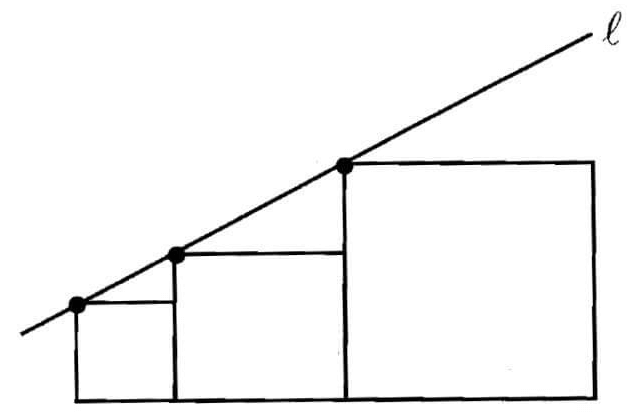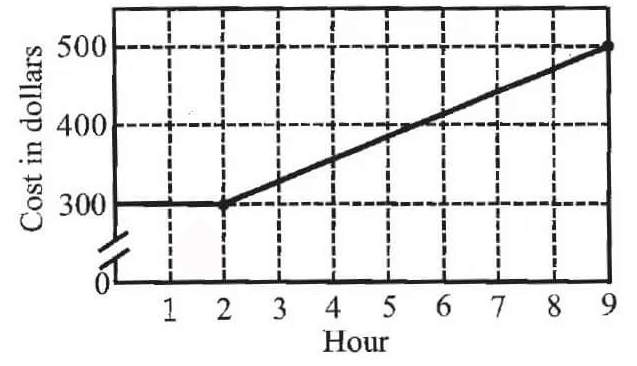FIND AREA OF QUADRILATERAL WITH VERTICES
Let us consider the quadrilateral ABCD shown below.
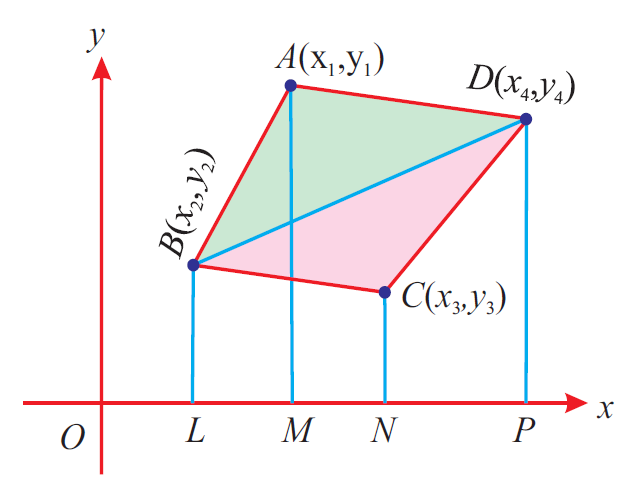
In the above quadrilateral, A(x1, y1), B(x2, y2), C(x3, y3) and D(x4, y4) are the vertices.
To find area of the quadrilateral ABCD, now we have take the vertices A(x1, y1), B(x2, y2), C(x3, y3) and D(x4, y4) of the quadrilateral ABCD in order (counter clockwise direction) and write them column-wise as shown below.

Add the diagonal products x1y2, x2y3, x3y4 and x4y1 are shown in the dark arrows.
(x1y2 + x2y3 + x3y4 + x4y1) -----(1)
Add the diagonal products x2y1, x3y2, x4y3 and x1y4 are shown in the dotted arrows.
(x2y1 + x3y2 + x4y3 + x1y4) -----(2)
Subtract (2) from (1) and multiply the difference by 1/2 to get area of the quadrilateral ABCD.
So, area of the quadrilateral ABCD is
= (1/2) ⋅ {(x1y2 + x2y3 + x3y4 + x4y1)
- (x2y1 + x3y2 + x4y3 + x1y4)}
Example 1 :
Find the area of the quadrilateral whose vertices are at
(–9, –2), (–8, –4), (2, 2) and (1, –3)
Solution :
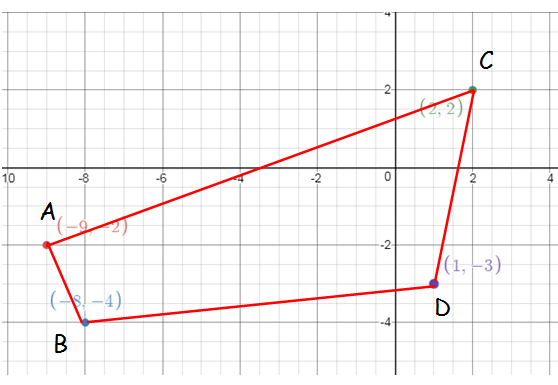
By taking the points in counter clock wise, we have to find the area of CABD.

= (1/2)[(-4 + 36 + 24 + 2) - (-18 + 16 - 4 - 6)]
= (1/2)[(62-4) - (-28 + 16)]
= (1/2)[58 - (-12)]
= (1/2)(58 + 12)
= (1/2)(70)
= 35 square units.
Example 2 :
Find the area of the quadrilateral whose vertices are at
(–9, 0), (–8, 6), (–1, –2) and (–6, –3)
Solution :
By plotting the given points in the graph paper, we get
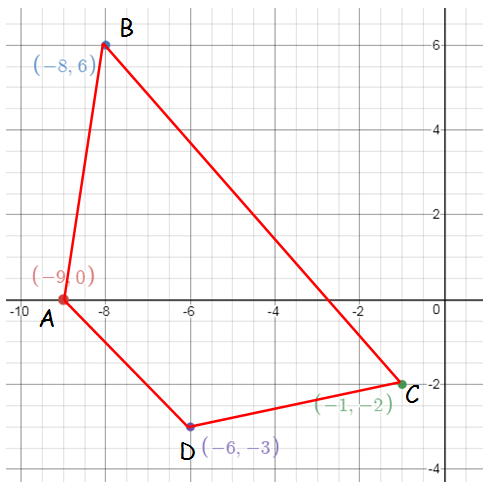
By taking the points in counter clock wise direction, we find the area of BADC.

= (1/2)[(0 + 27 + 12 - 6) - (-54 + 0 + 3 + 16)]
= (1/2)[(39 - 6) - (-54 + 19)]
= (1/2)[(33) - (-35)]
= (1/2)(33 + 35)
= (1/2) (68)
= 34 square units.
Example 3 :
Find the value of k, if the area of a quadrilateral is 28 sq. units, whose vertices are (–4, –2), (–3, k), (3, –2) and (2, 3)
Solution :
Area of quadrilateral = 28 square units

[(-4k + 6 + 9 - 4) - (6 + 3k - 4 - 12)] = 28(2)
(-4k + 11) - (3k - 10) = 56
-4k + 11 - 3k + 10 = 56
-7k = 56 - 21
-7k = 35
k = 35/(-7)
k = -5
Example 4 :
If the points A(-3, 9), B(a, b) and C(4, -5) are collinear and if a + b = 1, then find a and b.
Solution :
a + b = 1 ----(1)
Because the given points are collinear,
area of triangle = 0

[(-3b - 5a + 36) - (9a + 4b + 15)] = 0
-3b - 5a + 36 - 9a - 4b - 15 = 0
-5a - 9a - 3b - 4b + 21 = 0
-14a - 7b + 21 = 0
2a + b = 3 ----(2)
(2) - (1) :
2a + b - (a + b) = 3 - 1
2a - a + b - b = 2
a = 2
Substitute a = 2 in (1).
2 + b = 1
b = -1
Example 5 :
If the area of the quadrilateral whose angular points, taken in order, are (1, 2), (–5, 6), (7, –4), (p, –2) be zero, find the value of p.
Solution :
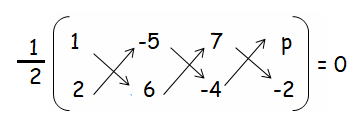
(6 + 20 - 14) - (-10 + 42 - 4p) = 0(2)
(26 - 14) - (32- 4p) = 0
12 - (32 - 4p) = 0
12 - 32 + 4p = 0
-20 + 4p = 0
4p = 20
p = 20/4
p = 5
So, the value of p is 5.
Example 6 :
Find the area of the quadrilateral 𝐴𝐵𝐶𝐷 whose vertices are 𝐴(−3, −1), 𝐵(−2, −4), 𝐶(4, −1) and 𝐷(3, 4).
Solution :
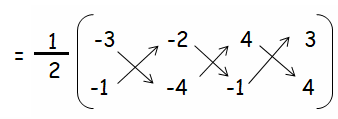
= (1/2) [(12 + 2 + 16) - (2 - 16 - 3)]
= (1/2) [30 - (2 - 19)]
= (1/2) [30 - (-17)]
= (1/2) [30 + 17]
= (1/2) (47)
= 23.5 square units.
Example 7 :
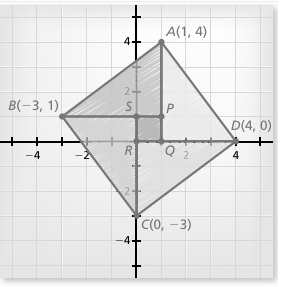
a. Quadrilateral ABCD is partitioned into four right triangles and one square, as shown. Find the coordinates of the vertices for the five smaller polygons.
b. Find the areas of the five smaller polygons. Area of Triangle BPA: Area of Triangle AQD: Area of Triangle DRC: Area of Triangle CSB: Area of Square PQRS:
c. Is the sum of the areas of the five smaller polygons equal to the area of quadrilateral ABCD? Justify your answer.
Solution :
a) P (1, 1), Q (1, 0) R (0, 0) and S(0, 1)
b) Area of triangle AQD :
Base = |4 - 1| ==> 3
Height = |4 - 0| ==> 4
Area of triangle = (1/2) x base x height
= (1/2) x 3 x 4
= 3 x 2
= 6 square units.
Area of triangle APB :
Base = |-3 - 1| ==> |-4| ==> 4
Height = |4 - 1| ==> 3
Area of triangle = (1/2) x 4 x 3
= 2 x 3
= 6 square units
Area of triangle BSC :
Base = |-3 - 0| ==> 3
Height = |-3 - 1| ==> 4
Area of triangle = (1/2) x 4 x 3
= 2 x 3
= 6 square units
Area of square PQRS :
Side length of square = 1 unit
Area of square = 12
= 1 square units
Area of quadrilateral ABCD :
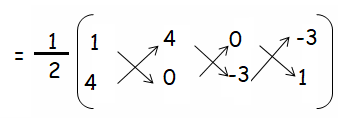
= (1/2)[(1 - 12 + 0) - (16 + 0 + 9)]
= (1/2) [-11 - 25]
= (1/2)(36)
Area of quadrilateral ABCD = 18 square units
Kindly mail your feedback to v4formath@gmail.com
We always appreciate your feedback.
©All rights reserved. onlinemath4all.com
Recent Articles
-
Digital SAT Math Problems and Solutions (Part - 146)
Apr 18, 25 06:52 AM
Digital SAT Math Problems and Solutions (Part - 146) -
Logarithmic Derivative Problems and Solutions
Apr 16, 25 09:25 PM
Logarithmic Derivative Problems and Solutions -
Digital SAT Math Problems and Solutions (Part - 145)
Apr 16, 25 12:35 PM
Digital SAT Math Problems and Solutions (Part - 145)
